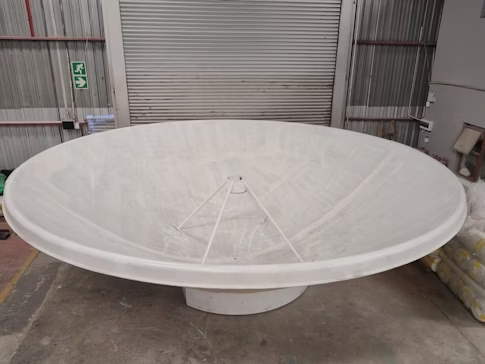First Dish Built for South Africa’s HIRAX Radio Telescope Array

An ambitious project to understand the nature of the mysterious dark energy pulling the universe apart has reached a major milestone. The Hydrogen Intensity and Real-time Analysis eXperiment, or HIRAX, has produced its first reflector dish. The dish — and the hundreds more to come — will measure the universe’s radio waves, helping trace the evolution of dark energy by measuring ripples present in the distribution of the universe’s hydrogen. The Simons Foundation is one of the project’s major funders.
“This array will allow us to look at radiation from hydrogen, the most abundant element in the universe. With these kinds of techniques, we can probe gigantic cosmological volumes to shed light on the nature of dark energy,” says HIRAX researcher Francisco Villaescusa-Navarro, a research scientist at the Center for Computational Astrophysics at the Simons Foundation’s Flatiron Institute. “This project will also help create scientific connections between countries in Southern Africa and around the world.”
Once completed, the HIRAX telescope array will be a cutting-edge compact telescope array in the Karoo Desert in South Africa. The array will initially consist of 128 dishes and eventually include more than 1,000 dishes. HIRAX will operate at radio frequencies of 400 to 800 megahertz and benefit from the radio-quiet skies in the South African Karoo Astronomy Reserve.
“This is a pivotal step forward for the HIRAX project on its journey to uncover the mysteries of the universe,” says Neil Koorbanally, chair of the HIRAX executive committee and a professor at South Africa’s University of KwaZulu-Natal.
The HIRAX team and its local industry partner, Advanced FibreForm (AFF), have achieved a significant technical feat by producing a dish that has excellent surface accuracy, roughly one millimeter over the extent of the six-meter dish, which is essential in capturing sensitive data from the universe’s radio waves. “The HIRAX science requirements set stringent constraints on the dish and had to be updated to meet local weather conditions,” says Corrie Ungerer, the HIRAX project engineer. “The local team, led by AFF, overcame a number of manufacturing and logistic challenges to deliver the first dish to specification.”

This feat would not have been possible without a close collaboration between scientists, engineers and industry. The dish uses a Canadian-made design provided by the National Research Council (NRC) of Canada, and HIRAX engineers also received hands-on experience at the council’s Dominion Radio Astrophysical Observatory. “Most astronomical observatories now rely on international partnerships for their successful completion. One of our roles is to enable this type of support for instrument development projects, which benefits Canada as well as our partners,” says Scott Roberts, director of research and development of the astronomy technology team at the NRC’s Herzberg Astronomy and Astrophysics Research Centre.
Built at the AFF factory in Cape Town, the first dish has served as a manufacturing test bed, allowing the HIRAX project team to work closely with AFF and industry partners to achieve the challenging accuracy requirements.
The confirmation of the accuracy of the final assembled dish, including the main reflector backing support and the antenna support structure, was led by Jennifer Studer, a Ph.D. student in the group of Alexandre Refregier at ETH Zurich, who leads the international partner team in Switzerland. She collaborated with two graduate students, Keshav Bechoo and Tasmiya Papiah, at the University of KwaZulu-Natal. Detailed measurements using a laser tracker and a photogrammetry system, secured for the project from a Swiss National Science Foundation research grant, were used to validate the dish shape and surface accuracy, as well as the position and orientation of the antenna support structure. “The completion of the first HIRAX dish is a major achievement, with meticulous measurements ensuring its precise shape and surface accuracy,” Studer says. “It is incredible to collaborate with such a diverse and talented team.”
Now that the first dish has been manufactured, the project is focusing its efforts on deploying two dishes to the HIRAX test-bed site at the Klerefontein support base in the Karoo, hosted by the South African Radio Astronomy Observatory. The test-bed array will be used to characterize the full performance of the telescope and to develop software tools for the analysis of radio data from the 128-dish array. In parallel, AFF will continue production of dishes at the HIRAX factory in Carnarvon, South Africa, which are destined for the 128-dish array at the main HIRAX site. AFF is also producing 16 dishes for a smaller HIRAX outrigger array that will be located at the Botswana International University of Science and Technology (BIUST). Kgomotso Thelo, who directs Botswana’s involvement in HIRAX, says that “preparations at BIUST are underway to host the HIRAX outrigger, and Botswana is looking forward to contributing to the scientific goals of the project.”
International and industry partnerships have played a key role in ensuring the ongoing success of the project. The HIRAX consortium is made up of 25 local and international partners, led by the University of KwaZulu-Natal. Kavilan Moodley, a professor at the university and the project’s principal investigator, says that “the first HIRAX dish is a testament to the strong collaboration between local and international partners and between scientists and industry, and the result of significant investments by our funding partners.”
Major funders of the HIRAX project include South Africa’s Department of Science and Innovation, South Africa’s National Research Foundation, the University of KwaZulu-Natal, the Swiss National Science Foundation, the Canada Foundation for Innovation, the Canada 150 Community Infrastructure Program, and the Simons Foundation in New York City.


